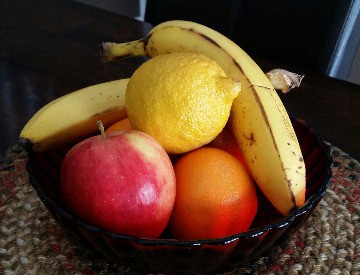 If you read my last post then you know the first thing you need to do for a healthier diet is to start reading food labels. Then you’ll know what’s actually in the processed foods you buy. The next step is to eat foods without labels. In other words, natural foods. These foods don’t need labels because they haven’t been altered in any way. The benefit of eating more natural foods is that it gives your body the necessary nutrients it needs to not just survive but to thrive with a stronger immune system.
If you read my last post then you know the first thing you need to do for a healthier diet is to start reading food labels. Then you’ll know what’s actually in the processed foods you buy. The next step is to eat foods without labels. In other words, natural foods. These foods don’t need labels because they haven’t been altered in any way. The benefit of eating more natural foods is that it gives your body the necessary nutrients it needs to not just survive but to thrive with a stronger immune system.
In this article, I’m focusing on plant-based foods because many meats are processed and sometimes seriously altered (that’s why so many need food labels). So instead, I’m talking about the whole fruits, vegetables, leafy greens, beans, nuts and seeds that are in their natural form when you buy them.
These are the foods that contain most of the nutrients we need more of. Plus, they’ve got no added sugars, salt, preservatives, or extra fat to worry about. This is what’s referred to as a “whole-foods, plant-based diet”. Eat the whole apple, as opposed to drinking the apple juice, eat the whole sweet potato rather than the sweet potato pie!
You can eat some meat too, I’m not trying to turn anyone vegan. But where Americans are really missing out in their diets is by not getting enough plants. Focusing more on whole plant foods as a source of energy and nutrition will steer us toward the vitamins, minerals and fiber we’re seriously missing.
Once you start focusing on eating foods without labels you’ll find that it’s not as hard as you think. It’s just about doing things a little differently. So let me tell you how you can start eating more naturally.
Encouragement to eat foods without labels
Eating more natural foods starts by shopping in the produce aisle of the grocery store. Once you buy what you want most of these foods need to be washed, and maybe cut up before eating them. This takes a little more effort than buying premade foods and this is what people hate!
So my recommendation is to do that prep as soon as you get home from the store. If you get them ready to eat immediately they’re easy to grab which encourages eating them sooner instead of letting them go bad!
For anything that doesn’t need refrigeration (like so many fruits) just put them in a bowl on the counter in plain sight. For the items that need to be kept cool, make sure you put them in a container at the front of the fridge. And try to use glass or see-through containers because if you can see them they’re unlikely to be forgotten or bypassed.
Then go the extra distance and put the junk food at the back of the fridge! Out of sight means out of mind!
Most people will eat fruits and veggies if they’re noticeable, convenient and easy to eat. But if any effort has to go into preparing them when you’re already hungry then that’s a deterrent! So prepare them right away and be done with it. You’ll also be happier later in the week if you got that task done right away.
Strategy #1 for a healthier diet
My strategy for eating more veggies is making homemade hummus every week. This is one of the simplest recipes I have and I like it so much I actually look forward to eating raw veggies every day at lunch! Even I can admit that I won’t eat my carrots without my dip!
Find yourself a great healthy dip and that might be all the encouragement you need to eat more natural foods too!
Add a salad
Leafy greens are another category of foods without labels that you really should add to your daily diet. They’re full of immune-boosting nutrients, fiber and they’re low in calories too. This is why salads are such a good premeal choice. They fill your stomach without too many extra calories so you eat less of the main meal.
Because of all the vitamins and minerals that leafy greens contain they’re known to help lower your risk of cancer. “One extra serving per day can lower the risk of cardiovascular disease by 11%” reports Advanced Health. But that’s not all, they also protect your eyes, your bones, keep your weight under control, and help prevent T2Diabetes.
You might also consider just eating a salad for lunch or dinner as your entree rather than as a starter. Salads are very versatile this way, it all depends on how many toppings you want to add to them. Check out Dr. Joel Fuhrman’s tips on making a meal out of a salad here on Youtube.
Just be sure your greens aren’t drenched in a high-calorie salad dressing! Some of the salads served at restaurants are as high in calories as the entrees due to the addition of unhealthy dressings and toppings. Remember to read the labels on salad dressings you buy so you know how much a serving is!
Strategy #2 for a healthier diet
Have a variety of toppings already chopped or prepared ahead of time and ready to add to a salad. Again, if you don’t have to make decisions and chop every time you want a salad it will be much easier to put one together on the go.
Salads are such a great way to add other natural whole foods like nuts, seeds, shredded carrots and other veggies, protein cooked ahead of time, and dried or fresh fruits. Here’s another great Youtube video for some easy salad ideas.
Experiment with recipes
In order to eat more natural foods, you’ll need to experiment with new recipes. People commonly complain that they just “don’t like” many vegetables. I think we’ve gotten so used to tasting everything with added sugar, salt, fat or special condiments that natural fruits and vegetables don’t taste like much anymore. But it’s also that they don’t try them in enough different ways.
Don’t write off a new food because you didn’t like it the first time you tried it. Experiment with different ways of cooking them or eating them raw with different dips. Take it from the food experts, you should try a new food 10-15 times before you decide whether or not you really like it. This applies to adults as much as children!
Try roasting a plain sweet potato and you’ll realize how much natural sugar is already in it! When I first started baking sweet potatoes and squash for my husband I would always add butter and brown sugar after baking them to get him to eat them.
Now I cut them up into cubes, add a little olive oil and salt to them, roast (bake) them, and we both love them! But they’re also great added to a casserole or salad full of other healthy additions. Sometimes it takes a little experimenting to find just the right way to prepare food to your liking. It’s a process and it takes time, so keep at it.
It’s no sin to have a veggie with some extra toppings added to it for more flavor if that’s how you like it. Just try to get them as close to their whole, natural state as possible. You can always get the unhealthy fried versions any time you want when you go out to eat! Just eat more natural foods at home.
Eat many and eat a variety
Most Americans are overfed but undernourished due to all the processed, unhealthy foods we eat. In other words, we’re eating a lot of calorie-rich junk that’s low in real nutrients. So we’re mostly overweight but not getting the vitamins, minerals, and phytonutrients we need for healthy bodies.
You may have heard the phrase “eat the rainbow”? That doesn’t mean Skittles! It means all the colors of the natural world. The more variety of real foods you eat the more nutrients you’ll get and the healthier you’ll be. What a great way to avoid disease and illness in the first place!
According to the CDC, “Federal guidelines recommend that adults eat at least 1.5 to 2 cups per day of fruit and 2 to 3 cups per day of vegetables as part of a healthy eating pattern”. And remember that french fries are NOT a vegetable!
Strategy #3 for a healthier diet
If you have a family then make it a game with them to try one new fruit and veggie each week! Or you can see who can eat the biggest variety each day! We tend to get stuck in patterns of eating the same foods all the time and don’t branch out with different options.
Remember, the more variety we get, the more nutrients we get. You may even find some new favorites!
One last strategy to help you eat the foods without labels!
I’ve already listed quite a few strategies to help you eat more natural foods but I’d like to add to that. When you’re feeling like snacking ask yourself this question:
“Am I actually hungry or do I just want to eat junk because I’m tired, stressed or feeling irritable?”
If you’re actually hungry then wouldn’t a healthy, natural food for a snack satisfy you better than chips or sweets? I find it amazing how often I want to eat junk because I’m tired or bored! Too often we’re trying to fill some emotional need with junk food. If you want to start eating healthy, then you need to change your mindset and identify your unhealthy coping mechanisms.
For every junk food or drink you consume, you’re filling your stomach with more calories than nutrients. If you eat the nutritious items first you’ll have less room for the junk that’s not doing you any good and may also be harming you.
Eating real food will make you feel better and when you feel better you’ll want to continue making healthy choices.
My final thoughts
Americans don’t eat enough natural foods which results in too little fiber, not enough nutrients to keep us healthy, and an epidemic of weight problems. By focusing on eating more natural plant-based foods the CDC says we could avoid many of the chronic health problems we’re dealing with.
Here’s my summary of how to eat more foods without labels.
-
- Shop in the produce aisle
- Prep food as soon as possible after shopping
- Put foods where they can be seen
- Make your own dip to encourage eating more veggies
- Eat leafy greens (salads) before one meal every day
- Replace a typical meal with a huge salad & lots of healthy toppings
- Have salad toppings chopped and ready ahead of time for convenience
- Continually experiment with new healthy recipes
- Try a new food at least 10-15 times before judging whether or not you like it
- Make it a game with your family to try a new fruit or veggie each week
- “Eat the rainbow” of fruits and veggies in a variety of colors
- Remind yourself that if you’re really hungry something healthy will fill you up better than junk food will!
In time and with experimentation, eating real whole foods will just seem natural to you. Trust me, I’ve made that transition! It doesn’t take that long to collect a huge pile of healthy recipes to choose from to make healthy eating easier. It’s really only difficult in the beginning when it’s new to you.
My hope for you is that you’ll come to look forward to eating more natural foods with your meals every day and you’ll look and feel better as a result. And feeling better is a huge motivation to keep up with those new habits!
In the comments below, tell me about a strategy you used to eat more foods without labels. Or just let me know how making some healthy changes to your diet has helped you!
Related articles: Change your diet for a healthier body.

